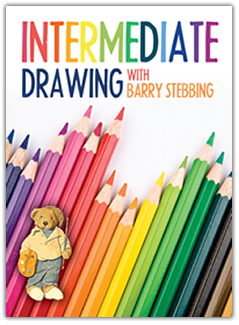Barry Stebbing has produced some wonderful drawing and art courses for Christian home educators, many of which have grown out of his experience teaching hundreds of children in classes around the country. Now students can experience Stebbing’s delightful and God-honoring teaching style themselves through his DVD lessons. Intermediate drawing has three DVDs with about eight hours of instruction divided into six parts. Students work only with drawing pencils and colored pencils.
I expect you that in one sitting you will want to have students tackle smaller sections within each of the six parts, practicing each technique before moving on. The six sections are titled, “Fundamentals,” “Treasures around the House,” “Animals,” “Portraits and Anatomy,” “Perspective and Depth,” and “Nature Studies and Landscape.” Stebbing introduces each section with illustrations of well-known art works so there is a little bit of art appreciation built into the presentations.
Students as young as about fourth grade should be able to work through the first two sections, but the level of difficulty increases as they learn how to draw animals and people. Fundamentals begins with basic geometric shapes, but lessons progress from there, gradually adding techniques such as shading, texture, shadows, overlapping, three-dimensional drawing, and color mixing. You might start using these lessons with nine- or ten-year-old children then come back to the lessons whenever they are ready to advance, even if that is a year later.
The lessons on drawing people include facial features and proportions, human body proportions, and drawing frontal or profile views. This is not intended to be a complete course in anatomical drawing, but it should give students at least some confidence in drawing people. Stebbing teaches how to draw realistic people as well as cartoon creatures. Children might find cartoon figures easier to tackle!
Some younger students might find the last two sections on perspective, depth, nature drawing, and landscapes easier than the sections on animals and people, so you might consider jumping ahead if they struggle with the third and fourth sections.
Stebbing walks students through each lesson step-by-step, discussing line placement, shapes, penciling, and other techniques so that students are not overwhelmed. Students should try to draw along with the lessons, so stop the DVD as needed so they can take their time with each step.
I have always liked the way Stebbing teaches through his books, and these DVD lessons make it even easier for those who learn better with direct teaching or just prefer this style of presentation.








